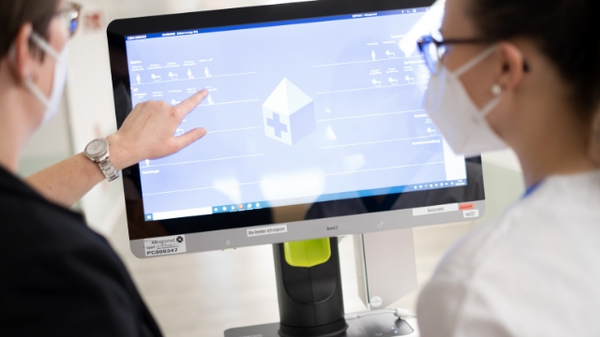Many hospitals - one system
How ANregiomed transformed IT service management into a central organisation.


ANregiomed is an association of the hospitals in Ansbach, Dinkelsbühl, Rothenburg as well as the Feuchtwangen practice clinic with about 2,300 employees.
User: ANregiomed gKU, AöR
Business: Hospital association
Business area: City and district of Ansbach
Employees: Around 2,300 employees in three clinics and one practice clinic
Task: Consolidation of the IT infrastructure of all locations
Solution: KIX Pro 17
Initial situation
"A hospital network needs a common IT infrastructure to achieve its strategic goals." Lars Forchheim knows this from experience. He is head of information technology at the ANregiomed hospital association in Central Franconia, a joint municipal enterprise of the district of Ansbach and the city of Ansbach. In 2012, they decided to combine the municipal medical infrastructure into a joint company.
The advantages of uniting the three acute hospitals and a practice clinic under one roof are obvious: uniform, coordinated processes, synergy effects in administration and cost advantages through centralised purchasing are the most important examples. Patients benefit from a comprehensive range of medical services in the network: basic internal and surgical care is provided at all locations and is supplemented by medical specialities at the individual hospitals as well as a comprehensive range of outpatient services in five medical care centres (MVZ). Administration is carried out in ten shared service centres that handle areas such as human resources, information technology, purchasing and logistics, finance & controlling/medical controlling or patient management.
The goal of Lars Forchheim and his staff at the DLZ IT is to equip the entire company with a common IT infrastructure. The basis for their work is an IT strategy adopted in 2019.

"KIX is uncomplicated and intuitive to use ... We can analyse the problems that arise or - for later expansion - create the billing basis for the support provided."
- Lars Forchheim, Head of Information Technology
The Project
In addition to adapting the systems, a central issue was the provision of an overarching support service for all company divisions. "The first thing we did was analyse the status quo," says Forchheim. The Information Technology Service Centre examined which form of IT support the different locations had used so far and discovered only a few commonalities: Some users preferred e-mail or telephone, others personal contact, while only one of the locations already had a ticket system.
In order to map the cross-hospital IT standards and guidelines in an ITIL-compliant manner, i.e. in accordance with the Information Technology Infrastructure Library, Forchheim's team created a catalogue of the employees' requirements in numerous workshops. Forchheim is convinced that "especially when different hospitals with a grown infrastructure merge, it is all the more important to create a so-called requirements specification that summarises all needs". ITIL defines the basic processes, roles and terms of an IT service organisation. "However, communication is the be-all and end-all for successful implementation. For this, you have to pick up the employees, involve them and also look to the left and right."
As part of a tender process, the company examined various systems and decided on KIX from cape IT, which convinced him the most, both because of its user-friendliness and in terms of cost-effectiveness. Since KIX enables a uniform, gradually expandable IT support, all company divisions can act as one organisation at the IT level. "Simple operation for the user ultimately also means simpler processing for IT support," says Forchheim.
The kick-off took place in January 2020, and the systems were provided and configured in February and March. After a Corona-related break in May, staff training took place in June. The version 17.12 system then went live in August, with the 17.13 update already applied for. "Internally, we are beyond the beta phase," sums up the Head of Information Technology. "We are already actively working with customer enquiries, but they are still created automatically from emails in KIX."
For external use, the input mask and templates for creating new tickets for customers are currently being prepared. "Since version 17.13 changes the design, we are still waiting for the update". Currently in the planning stage is the task overview of all IT topics such as maintenance, self-service for users, the administration and control of customer requests - i.e. classic support - as well as the administration and control of tasks within IT. "KIX is uncomplicated and intuitive to use," states Forchheim. "The service of the IT service centre should be transparent for the customer, i.e. all users in the company, and come closer to them," says Forchheim.
Conclusion
With over 1,000 tickets per month (as of Q4 2022), KIX is the central support tool of ANregiomed-IT. It supports the prioritisation of issues every day and is a communication hub, documentation and help for agents and users alike. Internal users can keep track of the processing status at any time until the problem or request is finally solved. Forchheim sees the possibility of working flexibly across locations as a big plus: A problem can be answered by different contacts. This prevents dependency on one expert and possible annoying waiting times if the expert is ill or on holiday. Instead, different employees can take on the problem and solve it as quickly as possible.
And Forchheim sees another advantage in working with KIX: "We can analyse the problems that arise or - for later expansion - create the billing basis for the support provided." When the IT of the hospital network functions so smoothly, it is a win-win situation: for the hospitals, the information technology service centre and ultimately for the patients. "My team and I help to ensure that the primary processes in medicine and care run efficiently and reliably. Indirectly, this has an impact on the quality of care," says Forchheim, "and this is particularly important not only in times of Corona.
Status: 2020